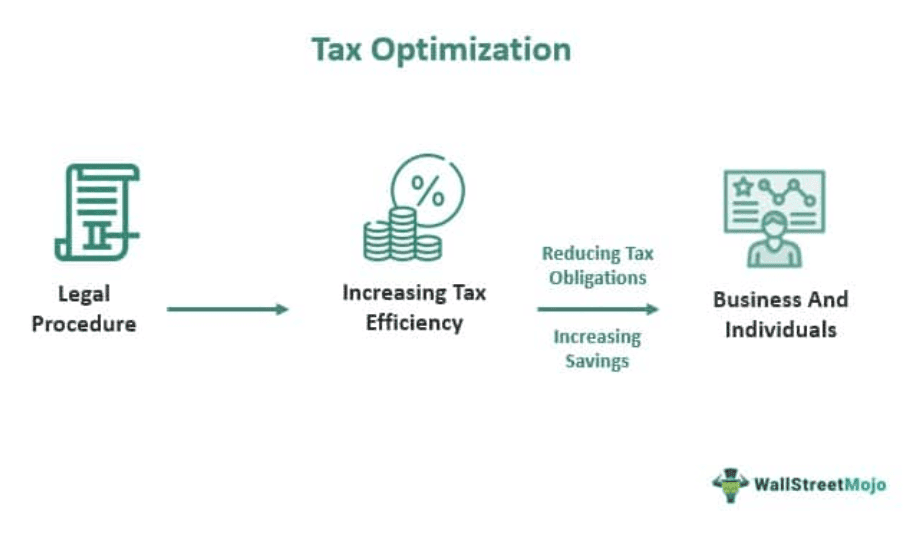Table Of Contents
What Is Tax Optimization?
Tax optimization refers to the legal procedure of increasing tax efficiency and reducing tax obligations for businesses and individuals. It aims to enhance the procedure of tax payment and reduce liabilities for people, by managing financial resources and adhering to tax legislation through a long-term view of financial stability.

It is not tax fraud, as it comprises a legal mechanism for avoiding payment of taxes. Moreover, it increases after-tax income, enhances cash flow, and reduces tax audit risks. These also involve fundamental principles like planning, knowing the tax laws, considering one's whole options, and seeking advice professionally.
Key Takeaways
- Tax optimization involves strategically managing financial affairs to minimize tax liability within the legal framework.
- Its type includes tax deferral, income splitting, capital gains management, charitable giving, business tax planning, estate planning, tax-loss harvesting, and real estate tax strategies.
- Moreover, its strategies include strategic income recognition, entity structure evaluation, accounting method review, effective bookkeeping, maximizing retirement contributions, income shifting, strategic deduction timing, etc.
- It is the active reduction of tax obligations, while tax planning is the proactive organization of financial affairs with the goal of minimizing tax liabilities.
Tax Optimization Explained
Tax optimization is the application of tax laws and principles to reduce tax liability while also complying with every applicable regulation and law. It can also be seen as a strategy for evaluating all existing credits and deductions to maximize savings. It uses the most beneficial business structure and creates strategies for tax deferment on 529 or investment plans. Its work basically focuses on increasing savings and reducing taxes. This is done using deductions, maximizing retirement contributions, timing the sale of assets and credits, properly structuring assets and investment vehicles, and minimizing tax obligations.
Afterward, techniques like capital gains management and income splitting help optimize taxes. Moreover, its implications are different for individuals and businesses. For individuals, it implies tax liability reduction, increasing their savings and allowing expenditure on other activities. On the other hand, for businesses, it reduces the overall cost of conducting their business, making them more competitive. Its usability depends on many factors like financial goals, complexity of one's financial situation, and income level.
It plays a critical role in the economy and financial world. Additionally, it tends to influence business strategies, economic growth, and investment decisions. Businesses and individuals reduce their tax payments and burdens, leading to surplus funds for reinvesting into economic activities. As a result, the economic growth and development of a nation increase, adding employment and generating income.
However, the use of tax optimization software has revolutionized financial planning, allowing individuals and businesses to map out effective strategies. Creating a comprehensive tax optimization calculator is a complex task and generally requires a deep understanding of tax laws, financial planning principles, and programming skills. Furthermore, portfolio tax optimization enables savvy investors to minimize taxes on their investment earnings, enhancing their overall returns.
Types
Tax optimization is the application of a number of legal-bound procedures and tactics to reduce tax liabilities. Legal professionals and tax advisors recommend certain methods to get relief from tax burden:
- Tax Deferral: It is a financial strategy involving delayed payment of taxes to a future date, allowing investment of tax savings and generating additional income over time.
- Income Splitting: It means reducing the overall tax liability of a family by shifting income from a high-tax to a low-tax earner, leading to less tax payment.
- Capital gains management: This leads to correct tax payment on capital gains while mitigating the overall tax burden upon selling assets. It comprises selling and investing assets, minimizing the tax impacts of capital gains.
- Charitable Giving: Reduces taxable income, leading to tax credits or deductions when money or property is donated to qualified charities.
- Business Tax Planning: Helps find ways to reduce tax obligations of businesses so that they can retain higher profits, allowing them to grow and be competitive.
- Estate and Inheritance Planning: Makes plans to distribute assets after death, minimizing taxes and ensuring that the designated beneficiaries get assets quickly. It protects assets from unwanted tax burdens, paving the way for the fulfillment of wishes even after death.
- Health and Retirement Accounts: Some exceptional health and retirement accounts like 401(k)s and IRAs entail tax-advantaged savings for the future. It facilitates tax-free or tax-deferred growth of savings, increasing savings significantly over time.
- Tax-Loss Harvesting: Here, one sells investments that declined in value to offset capital gains, decreasing tax liability. As such, the current year's tax bill gets reduced and utilized to offset future capital gains.
- Real Estate Tax Strategies: This service helps clients save money on actual estate-related expenses, mortgage interest deductions, and property taxes by finding methods to mitigate the tax obligations of owning real estate.
Strategies
It incorporates the application of several strategies allowed by the law to minimize tax obligations and improve tax efficiency for both people and corporations. Some of the major ones are listed below:
- Strategic Income Recognition: To control cash flow and lessen immediate tax obligations, use strategic revenue recognition.
- Entity Structure Evaluation: To reduce tax liabilities and improve tax efficiency, assess corporate entity arrangements.
- Accounting Method Review: Examine accounting practices to maximize tax efficiency and unearth tax advantages.
- Effective Bookkeeping: Ensure proper bookkeeping to find new deductions and reduce tax liability.
- Investment in Municipal Bonds: Invest in tax-exempt municipal bonds to lower the burden of taxes and taxable income.
- Maximize Retirement Contributions: Make pretax contributions to retirement accounts to postpone paying taxes on certain earnings and to shield some income from taxation.
- Income shifting: Divide the income among loved ones or legal organizations to receive a reduced tax rate on a more significant portion of it.
- Strategic Deduction Timing: To optimize tax benefits, consider deducting time-related costs.
- Tax Deferral Strategies: To postpone paying taxes on certain income until later years, defer taxes on assets or contributions to pension plans.
- Tax-Loss Harvesting: Reduce taxes and create losses by purposefully selling assets to offset capital gains.
Examples
Let us use a few examples to understand the topic.
Example #1
Imagine Jake is looking to optimize his income tax liability. One effective strategy involves taking advantage of tax-advantaged accounts such as an Individual Retirement Account (IRA). By contributing the maximum allowable amount to an IRA, he can reduce the taxable income, leading to potential tax savings. Additionally, strategic timing of capital gains and losses can play a crucial role. Selling investments with capital losses can be strategically timed to offset capital gains, thereby minimizing the overall tax liability on investment income.
He might also explore eligible tax credits, such as the Child Tax Credit or the Lifetime Learning Credit for education expenses, to further reduce the amount of taxes owed. Furthermore, if he is a homeowner, deducting mortgage interest and property taxes can contribute to tax optimization. Thus, this comprehensive approach, involving contributions to tax-advantaged accounts, strategic management of investment gains and losses, utilization of available tax credits, and maximizing eligible deductions, showcases a personalized tax optimization strategy that aligns with his financial goals and circumstances.
Example #2
Let's say John is a US citizen who runs a small company that sells handcrafted goods. His goal is to minimize his tax liabilities while maximizing his tax benefits. For this, John decides to register his company in a state with more advantageous tax legislation and lower tax rates. Additionally, he takes advantage of tax credits and deductions for small companies, such as the qualifying business income deduction and the home office deduction.
To lower his current tax obligation, John also postponed a portion of his income to the following year. By utilizing these tax optimization tactics, John is able to comply with tax rules and regulations while decreasing his tax burden and increasing his after-tax revenues.
Tax Optimization vs Tax Planning
Both tax optimization and tax planning are crucial aspects of financial planning. The usage of each depends on the individual goal and circumstance. Hence, the table below aptly shows the differences between the two:
| Tax Optimization | Tax Planning |
|---|---|
| Tax optimization is a legal process of reducing tax obligations and increasing tax efficiency for all. | Refers to organizing and planning financial affairs so that tax liabilities get minimized. |
| It minimizes tax liability. | Helps in maximizing after-tax income. |
| Here, it is a continuous process throughout the financial year. | Gets dine at the end of the financial year periodically. |
| Thus, it considers all aspects of the finances of a person or a business in a comprehensive manner. | It is focused on credits and deductions. |
| Presence of a higher degree of complexity than tax planning | These have simpler methods as compared to tax optimization. |
| They require the involvement of a legal tax advisor. | This can be done by oneself or by getting help from a tax advisor. |
| It is costly to do as it needs a legal tax advisor. | Moreover, it is affordable to perform. |
| Comprises strategies like investing in tax-advantaged investments, deferring taxes, and choosing the right business entity structure. | Includes strategies like timing income and expenses, maximizing deductions, and claiming credits. |

